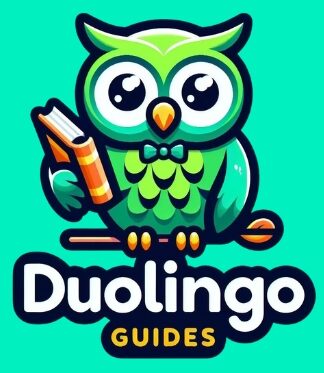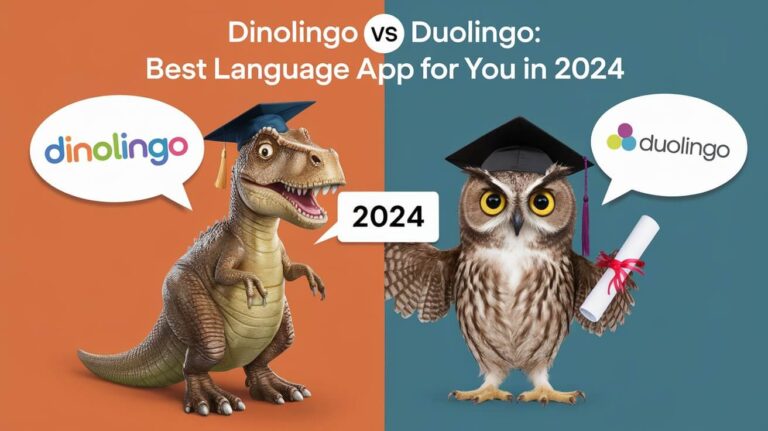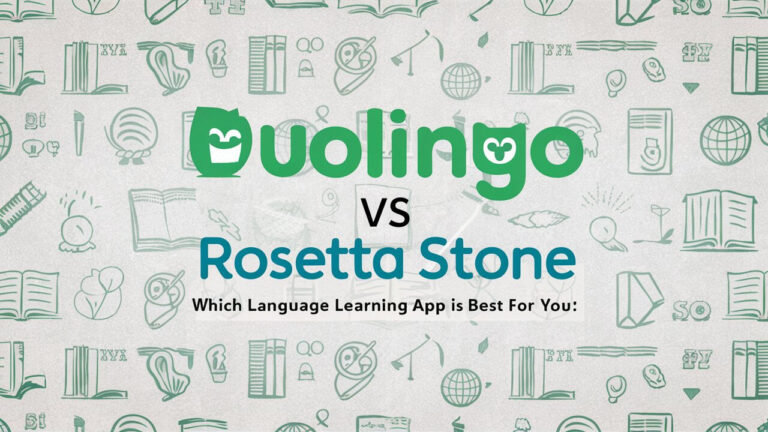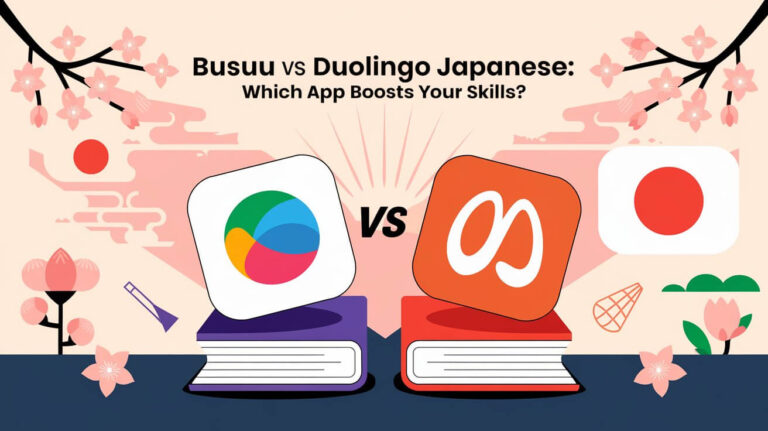Dreaming of la dolce vita? Learning Italian can make it a reality. But picking the right language app isn’t easy. Babbel and Duolingo are top choices for Italian learners, each with its own style.
This guide compares them head-to-head. We’ll look at how they teach grammar, build your vocab, and help you speak. By the end, you’ll know which app fits your Italian goals best. Ready to start your Italian adventure? Let’s find your perfect learning partner.
Babbel and Duolingo at a Glance
Babbel’s Approach to Italian Learning
Babbel takes a structured approach to teaching Italian. It focuses on practical conversations and real-life scenarios. The app builds your skills step by step, starting with basic phrases and moving to more complex topics.
Babbel’s Italian course covers:
- Everyday conversations
- Grammar explanations
- Cultural insights
- Pronunciation practice
Duolingo’s Italian Course Structure
Duolingo makes Italian learning feel like a game. It uses short, bite-sized lessons to teach vocabulary and grammar. The app’s tree-like structure lets you progress through different skills and levels.
Duolingo’s Italian program includes:
- Gamified lessons
- Vocabulary drills
- Basic grammar exercises
- Listening and speaking tasks
Lesson Format and Content Comparison
Babbel’s Italian Lessons Breakdown
Babbel’s lessons are about 10-15 minutes long. They mix different types of exercises to keep you engaged. You’ll find:
- Dialogue practice
- Fill-in-the-blank exercises
- Matching activities
- Speaking drills
Each lesson builds on the previous one, creating a smooth learning path. Babbel also includes cultural notes to help you understand Italian context and customs.
Duolingo’s Italian Learning Path
Duolingo’s lessons are shorter, usually around 5 minutes. They use a variety of quick exercises like:
- Translating words and phrases
- Matching pairs
- Speaking short sentences
- Multiple-choice questions
The app’s strength lies in its repetition. You’ll see words and phrases multiple times in different contexts. This helps cement the language in your memory.
Grammar Instruction: Babbel vs Duolingo
How Babbel Tackles Italian Grammar
Babbel shines when it comes to grammar explanations. It offers:
- Clear, concise grammar rules
- Examples in context
- Practice exercises for each concept
The app introduces grammar gradually, tying it to real-life usage. This approach helps you understand not just the rules, but when and how to apply them in Italian conversations.
Duolingo’s Approach to Italian Grammar Rules
Duolingo takes a more implicit approach to grammar. Instead of detailed explanations, it relies on:
- Pattern recognition
- Repeated exposure to structures
- Brief tips and hints
While this can work for some learners, others might find it lacking in depth. If you prefer thorough grammar explanations, Babbel might be a better fit for Italian study.
Vocabulary Building Strategies
Babbel’s Italian Vocabulary Techniques
Babbel focuses on practical, everyday Italian vocabulary. Its methods include:
- Thematic lessons (e.g., food, travel, work)
- Spaced repetition for review
- Context-based learning
The app also teaches idiomatic expressions, helping you sound more natural in Italian. Babbel’s vocabulary is carefully chosen to be immediately useful in real-life situations.
Duolingo’s Word Acquisition Methods
Duolingo uses several techniques to build your Italian vocabulary:
- Frequent word repetition
- Visual aids and images
- Word association exercises
The app introduces new words gradually and reinforces them through various activities. However, some users find that Duolingo sometimes teaches less common or practical vocabulary.
Speaking and Pronunciation Practice
Babbel’s Conversational Italian Focus
Babbel puts a strong emphasis on speaking Italian from day one. Features include:
- Speech recognition technology
- Pronunciation feedback
- Dialogue practice
The app encourages you to speak out loud, helping you gain confidence in your Italian pronunciation. Babbel’s native speaker audio also provides excellent models for correct Italian sounds.
Duolingo’s Italian Speaking Exercises
Duolingo incorporates speaking practice, but to a lesser extent than Babbel. Its speaking activities include:
- Repeating words and phrases
- Speaking short sentences
- Basic pronunciation checks
While these exercises can help, they’re not as comprehensive as Babbel’s speaking focus. For learners prioritizing conversation skills, Babbel might have an edge in Italian practice.
Writing and Reading Skills Development
Babbel’s Italian Writing Approach
Babbel integrates writing practice throughout its Italian course:
- Typing exercises
- Sentence construction tasks
- Short writing prompts
These activities help reinforce grammar and vocabulary while improving your Italian writing skills. Babbel also exposes you to authentic Italian texts, boosting your reading comprehension.
Duolingo’s Reading and Writing Practices
Duolingo’s approach to reading and writing in Italian includes:
- Translating sentences
- Arranging words to form sentences
- Reading short passages
The app gradually increases the complexity of these tasks as you progress. However, some users find that Duolingo’s writing practice lacks the depth needed for more advanced Italian expression.
Progress Tracking and Motivation
Babbel’s Goal Setting and Progress Monitoring
Babbel helps you stay on track with your Italian learning through:
- Personalized review sessions
- Progress indicators for each skill
- Completion percentages for lessons
The app’s progress tracking is straightforward, focusing on your actual learning rather than gamified elements.
Duolingo’s Gamification and Streak System
Duolingo is known for its motivational features:
- Daily streaks and rewards
- Competitive leaderboards
- Experience points (XP) and levels
These game-like elements can be highly motivating for some learners. However, others might find them distracting from the core task of learning Italian.
Pricing and Subscription Models
Babbel’s Cost Structure for Italian Learners
Babbel operates on a subscription model:
- Monthly plans start around $17.95
- Longer subscriptions offer better value (e.g., $6.95/month for a 12-month plan)
- Occasional discounts and promotions
While not free, many users find Babbel’s structured approach worth the investment for serious Italian study.
Duolingo’s Free vs. Paid Options
Duolingo offers two tiers:
- Free version with ads and limited features
- Duolingo Plus (around $6.99/month) with no ads and extra features
The free version is great for casual learners, but serious Italian students might prefer the ad-free experience and additional content of the paid version.
User Experience and Interface
Navigating Babbel’s Italian Course
Babbel’s interface is clean and user-friendly:
- Clear lesson progression
- Easy-to-navigate course structure
- Minimalist design
The app’s layout helps you focus on learning Italian without distractions. It’s particularly well-suited for adult learners who appreciate a straightforward approach.
Duolingo’s App Design for Italian Study
Duolingo’s interface is colorful and engaging:
- Cartoonish characters and animations
- Visual skill tree for progress
- Gamified elements throughout
This design can be fun and motivating, especially for younger learners or those who enjoy a more playful approach to studying Italian.
Additional Features and Resources
Babbel’s Supplementary Italian Learning Tools
Babbel offers several extras to enhance your Italian learning:
- Podcast-style lessons
- Cultural articles about Italy
- Live online classes (for an additional fee)
These resources provide valuable context and extra practice for motivated Italian learners.
Duolingo’s Extra Features for Italian Mastery
Duolingo also provides additional tools:
- Stories for reading practice
- Duolingo Events (online meetups)
- Discussion forums
These features can add variety to your Italian studies and connect you with other learners.
Real User Reviews and Success Stories
Babbel Italian Learners’ Experiences
Many Babbel users praise the app’s structured approach:
- “Babbel helped me prepare for my trip to Italy. I felt confident ordering in restaurants and asking for directions.”
- “The grammar explanations are clear and helpful. I finally understand Italian verb conjugations!”
Some users note that Babbel requires more self-discipline, as it feels more like a traditional course.
Duolingo Italian Users’ Feedback
Duolingo users often highlight the app’s accessibility and fun factor:
- “Duolingo’s daily reminders keep me consistent with my Italian practice.”
- “I love competing with friends on the leaderboard. It motivates me to study Italian every day.”
However, some users mention that they need additional resources for more in-depth Italian learning.
Final Thoughts
Both Babbel and Duolingo offer valuable tools for learning Italian, but they suit different needs:
Choose Babbel if you:
- Want structured, comprehensive Italian lessons
- Prefer clear grammar explanations
- Focus on practical, conversational Italian
- Don’t mind paying for a quality language learning app
Choose Duolingo if you:
- Enjoy a gamified learning experience
- Want a free option to start learning Italian
- Like bite-sized, varied lessons
- Thrive on competitive elements and streaks
Ultimately, the best app for learning Italian depends on your personal learning style, goals, and budget. Some learners even use both apps to complement each other. Whichever you choose, consistency is key to making progress in your Italian journey.
Remember, no single app can make you fluent in Italian. Supplement your chosen app with Italian movies, music, and conversations with native speakers for the best results. (Buona fortuna con il tuo studio dell’italiano) Good luck with your Italian studies!








Ciao! As an Italian living in Rome who teaches English, I found this comparison really interesting! I often have students who use these apps to learn Italian before moving here. What I’ve noticed is exactly what you mentioned – Duolingo students know lots of random words but struggle with real conversations, while Babbel students speak more naturally from the start. One tip I give my students: whichever app you choose, please please PLEASE find Italian songs or Netflix shows to listen to as well! The apps are great for basics but you need to hear real Italian too. Buono studio a tutti!
Grazie mille for your insight, Marco! Having feedback from an Italian teacher adds so much value to this discussion. Your real-world observations about how students from each app perform in actual conversations perfectly validates what my research showed. I absolutely agree with your recommendation about supplementing with Italian media – it’s crucial for developing an ear for authentic language patterns and rhythm. I might update the article to emphasize this point even more strongly. Songs and shows not only improve listening comprehension but also provide cultural context that no app can fully capture. Thanks for taking the time to share your professional perspective!